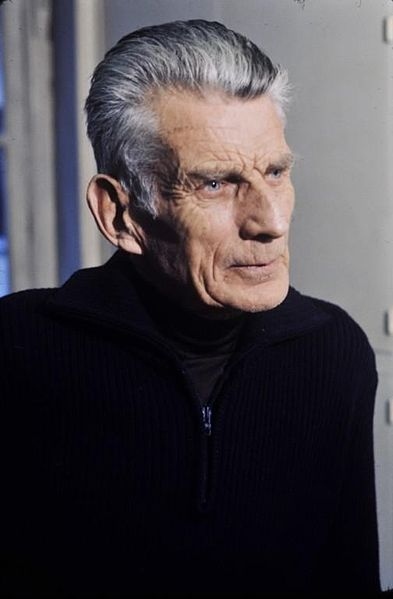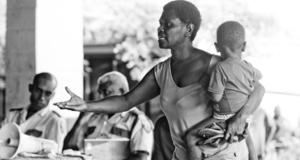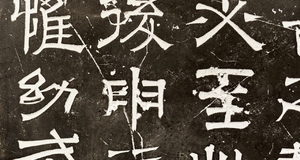Unclean, Unsaid, Undead: Beckett, Merleau-Ponty, and the Degradation of Body and Language
By
2013, Vol. 5 No. 09 | pg. 1/3 | »
IN THIS ARTICLE
KEYWORDS
Life is pain. And life persists, obscure,
but life for all that, even in the tomb. Matter disintegrates and is dispersed; the eternal spirit, the underlying essence suffers without pause. It were in vain to wield the suicidal steel. Suicide is unavailing. The form is changed, the indestructible being endures.1 Beckett’s translation of Manuel Gutiérrez Nájera’s poem from Anthology of Mexican Poetry, which he titled, “To Be.” Critical scholarship on Samuel Beckett has tended to apply a wide canon of theoretical and philosophical impositions onto a body of work that, for the author, was resistant – and often violently so – in its minimalism, to such applications. Yet, despite this affirmation of resistance, the Beckett canon has generated entire fields of critical and theoretical work, and his contemporaries in literature, philosophy, and theory have emerged, in parallel fashion, with ideas that complement and substantiate the increasingly attenuated form of Beckett’s writing. To study the myriad ways in which Beckett engages with philosophical implications within his text necessitates an understanding of how the texts command some sort of philosophical work; that is to say, one must go beyond simply listing instances in which philosophical themes emerge in the work and consider how they apply within the text.2 Phenomenological interpretations of Beckett’s work have attempted to imbue the recurring themes of the oeuvre – such as memory, perception, imagination – with an abstract and often impenetrable dialectic that is far removed from both the content and form of the original text; however, the possibility for such an application still persists. Samuel Beckett, 1977 This examination of Beckett’s prose as it relates to topics endogenous to phenomenology will focus on the theme of decay and disintegration as it relates to the corporeal and the phenomenal body. Grounded in a study of the occasion of phenomenology as posited by Maurice Merleau-Ponty, I will attempt to trace the radical degradation of the physical body in the post-war prose works of Samuel Beckett that I argue parallels Beckett’s attenuation of prose and reduction of language to its bare forms across the course of the Beckettian canon. For the purposes of comparative analysis, J.M. Coetzee’s novel Waiting for the Barbarians will serve to further elucidate how the torture and degradation of the body, in concurrence with the paring down of language, reveals what might be residua of subjectivity. This leads to a point of critical divergence: whereas Coetzee brings the body to its physical limits of pain as a means to reveal an underlying subjectivity, Beckett’s emptying of subjectivity in the later works of How It Is and the later prose is an attempt to find the “something” (or nothing) that lies behind subjectivity. Understanding that this radical decomposition may potentially reveal what might be termed as an “essence,” or semblance thereof, both Beckett and Coetzee serve to unwork Merleau-Ponty’s interpretation of the body as the source of phenomenological experience. Discussion: Merleau-Ponty and the Phantom Objective BodyThe phenomenology of Maurice Merleau-Ponty is a philosophy that although rooted in the tradition of Edmund Husserl, insists upon a focus on the body as the source of all experience. Merleau-Ponty establishes a system of thought in which the body is necessarily in the world, keep the world alive, and sustains it, establishing a dialectical naturalism in which the human subject and the world are intertwined.3 His landmark opus, the Phenomenology of Perception, is an attempt to reach the “present and living reality of perception,” to return to the experience not only as rooted in corporeality but inextricable; the body is used as a intermediary for understanding the conditional that the world is inseparable from a subjective experience of the world.4 In his insistence upon the body as the source of experience, Merleau-Ponty attempts to uncover the dialectical relationship between subject and object – a relationship that Beckett will explore and ultimately eradicate in his texts. In order to understand the position of the body in this dialectic, we must understand the role that our body plays in the world. For Merleau-Ponty, the body is simultaneously the source of our point of view of the world and one of the objects of that world.5This body is divided into two complementary halves: the ‘phenomenal’ body (that which explores movements before actually performing them), and the ‘objective’ body (that which does the moving). Of great concern to Merleau-Ponty was the ways in which this objective body fails and becomes deficient. His study of the phantom limb emphasizes the effect of habit and time on the body as it relates to the body’s deficiencies. When a person loses a limb, the neurological condition of feeling pain in that limb is tied to the subject’s past experiences in that limb’s function. Thus, the phantom limb is felt in relation to the objects that surround it – playing a piano, for instance, calls the attention to the missing hand. However, the piano can still be understood as a thing ‘to be played’ because past experience structures a “habitual body,” one that has accumulated a repository of knowledge to structure the experience of being in the world that it occupies.6 It is clear here, that there lies a close and distinctive relationship between the body, its perceptions that define the world around it, and its capacity for memory. In Beckett’s prose, understanding the degradation of the body and the emptying of subjectivity may be linked to memory as a codex for identifying the residua that remain. Merleau-Ponty’s discussion of the phantom limb serves as a clue for understanding the disintegration of the objective body as it relates to memory and subjectivity. Ulrika Maude points out, for instance, that the titular character of Krapp’s Last Tape is “involved in a process of involuntary memory as he listens to himself (or his former selves) describe specific images…his body, rather than his mind, recollects the past through sensory experience.”7However, evidenced in both the prose works of Beckett and Coetzee’s novel, this reliance comes apart as the language becomes increasingly attenuated. Subject/Abject: Molloy and How It IsTextual evidence across the Beckettian canon signals the body as an entity that must, from its birth, involve itself in a process of pain and torture tending toward death. This process of declining begins to manifest itself in the first novel of the trilogy, Molloy, who states that to “decompose is to live, too”8 A man who has “gone in terror of festered wounds, I who never festered, I was so acid,”9 the titular protagonist succumbs to the physical debilitation of his sore and malfunctioning limbs as he takes a journey, described by Hugh Kenner as a process of reducing the body to “physical wreckage,”10 to his mother’s house. This is not without its psychoanalytical implications. As Molloy journeys further and further into the forest, and as his body becomes increasingly debilitated, he tends toward a prenatal state. The novel in fact begins with Molloy in his mother’s room (womb), and as it progresses, Moran’s failing limbs and the machinery (bicycles, crutches) used to aid them fail. Once an ambulatory adult who was capable of bipedal motion, Molloy eventually is reduced to crawling through the dark forest as he comes closer to Molloy country, that space in which he and his cataloger, Moran, approach one another but never truly connect. This absent center of the novel is the point of departure of narrative continuity, because henceforth the reader is witness to the (unreliable) perspective of Moran’s attempts to find Molloy. This impossibility renders a subtle reading of a deep phenomenological problem outlined by Edmund Husserl – that of intersubjectivity or the impossibility of exchanging one’s own subjective experiences with another’s. The degradation of Molloy’s body is closely linked to its mobility, and the incapacity for movement parallels Molloy’s constant confrontation with the grotesque and abject throughout the novel. His relationship with the woman Lousse facilitates this confrontation and hinders bodily movement, for with her he did not need to clean nor wash himself if he chose not to11 and though he could initially stretch out his body with ease while she kneeled uncomfortably12, he developed an increasing tendency to collapse. This relationship is short lived, as he quickly (and seemingly, without remorse) replaces this object of his desire with another woman “by the peaceful name of Ruth I think, but I can’t say for certain.”13His sexual encounter with Ruth, described as a confusing arrangement where he “toiled and moiled until…discharged or gave up trying or was begged by her to stop”14 on the decrepit body of a woman afflicted with rheumatism and lumbago is an abject encounter, the culmination of which takes place when Molloy is “bent double over in a heap of muck.”15 According to French theorist Julia Kristeva, abjection is the process of rejecting the I as established in Freudian psychoanalysis when one encounters instances of filth and defilement such as excrement, vomit and decay that reminds the subject of his own humanity. In opposition to the Freudian position that subjectivity is constructed through the Oedipal rejection of the paternal prohibition, Kristeva asserts that subjectivity is cemented by rejecting those attributes that connect the subject to the mother and incorporating oneself into the Real.16 The maternal connection is apparent in this scene, where Molloy admits to doing more than “rubbing up against” his mother, and possibly even his grandmother.17 However, insofar as Molloy is concerned, his subjectivity cannot be constructed because he fails to reject filth and the abject; rather, as the novel wears on, he becomes more and more decrepit and entrenched in filth and mud, till mobility is rendered impossible. By the time Molloy is reduced to crawling through the forest, he is inseparable from his inextricable from his “psychological landscape (shore, swamp, dark wood and ditch), his journey ending in a painful birth that is equally a death.18 In his decrepitude and impaired movement, Molloy cannot separate himself from the filth and his subjectivity becomes lost in the void of the ditch. This climactic point draws comparison to Beckett’s work How It Is, a series of passages that describe an external voice or presence gives memory to a body that is devoid of such. Its tripartite “structure,” offered by the figure in question, catalogs his journey “before Pim” (in which he is mobile and encounters other presences), “with Pim,” where he lies in the mud until Pim leaves, and “after Pim,” where this figure is completely motionless and abandoned.19Beckett’s figure here is much like Molloy in the forest, where he lies supine and attempts to pull himself through the muck despite his impaired body.20 Compare this to the figure in How It Is, who “push pull the leg straightens the arm bends all these joints are working the head arrives alongside the hand flat on the face and rest”21 The infirm body in both these scenarios are entrenched in a primeval filth and muck that not only renders their bodies as primeval and ghastly, but constitutes their embodiment. Ensconced in the abject, they are unable to retain a subjectivity that they once had. This loss of subjectivity is a direct confrontation with the phenomenology of Merleau-Ponty, for whom the body is not only capable of providing subjectivity in the world, but offered the world to the subject in its entirety through its capacity for perception. It is evident particularly in How It Is that the body is not the source of experiences nor does it have the capacity for memory; these qualities are given to the body by an ever-present externality. In Merleau-Ponty, the body “functions as a register of experiences, carrying the past within it, and therefore providing the subject with a sense of continuity, while simultaneously, in its dynamic aspect, differing…”22 If, emptied out of its subjectivity, the body is incapable of possessing memory – which must be externally provided to it, then Beckett’s characters are applying pressure to Merleau-Ponty’s theory to the point of fissure. Here, the phenomenon of the phantom limb again comes into question in the case of both Molloy and the figure in How It Is. Molloy’s ambulatory impairment requires him to rest upon crutches, machine extensions of his corpus. If, for instance, these were to be removed from his body, they would offer him some solace from physical pain but his habitual body – once capable of riding a bicycle, walking, fucking – would not persist in drawing the relation of this legs to his surroundings because of his loss of subjectivity within the forest. Molloy was already in the process of decline from the start of the novel, and his rituals of sucking stones are not indicative of a habits that constitute the habitual body in the Merleau-Pontian sense; rather, they are empty gestures by which the establishes a pattern of consistency, but not necessarily a sense of self. Likewise, the figure in How It Is can discern a time before, during, and after Pim, but these distinctions are not tied to his body, which rests quivering in the mud. Though it is true that he was capable of mobility in the time before and during Pim, the connection is not quite the same as the phantom limb simply because these are imposed memories that are not directly or inherently connected to his physical body. I maintain, however, that despite this radical reduction of subjectivity there is something that yet remains, and this is tied to language – a connection discussed in a later section of this paper.Continued on Next Page » Suggested Reading from Inquiries Journal
Inquiries Journal provides undergraduate and graduate students around the world a platform for the wide dissemination of academic work over a range of core disciplines. Representing the work of students from hundreds of institutions around the globe, Inquiries Journal's large database of academic articles is completely free. Learn more | Blog | Submit Latest in Literature |


















